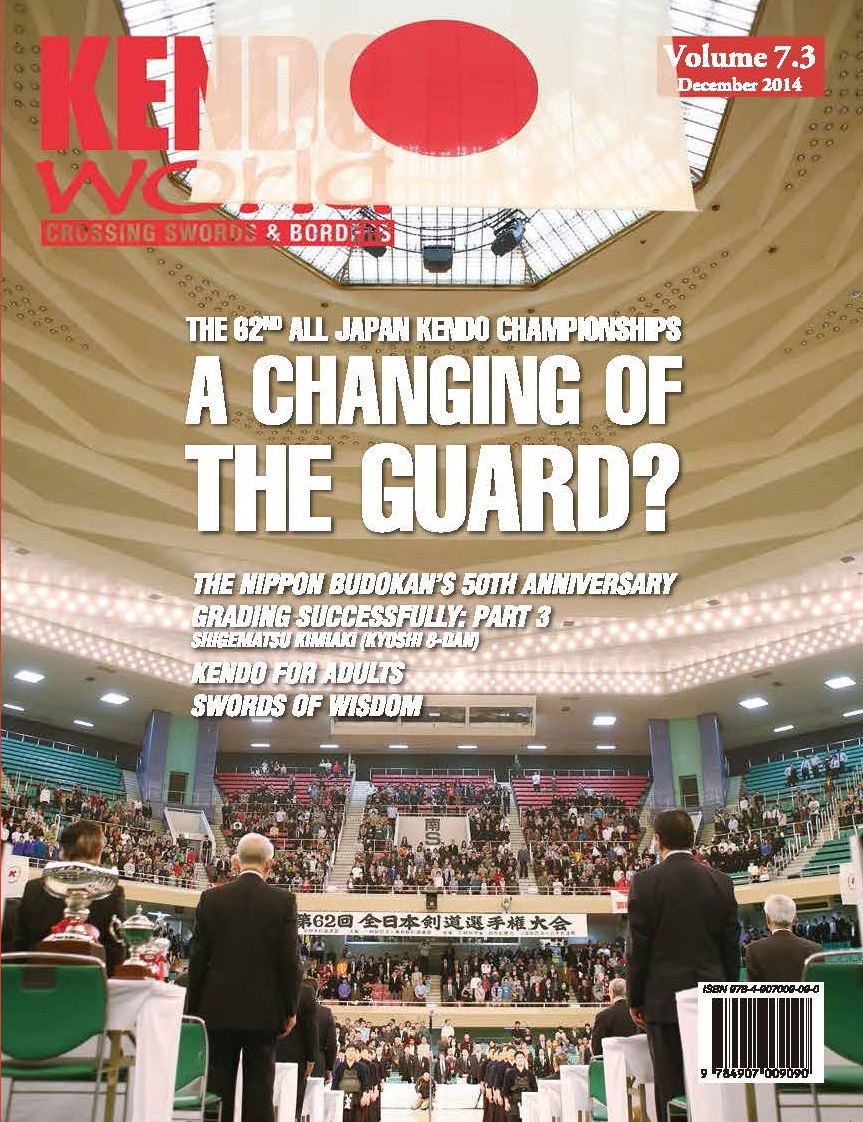
Kendo World 7.3
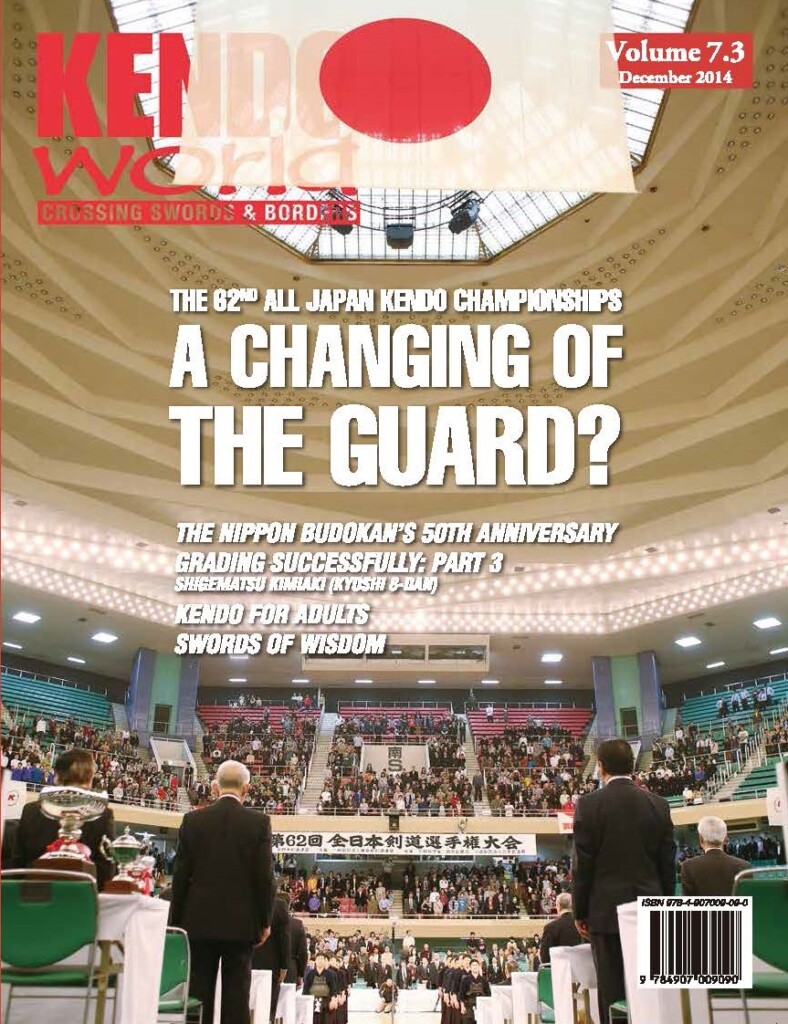
Editorial
By Alex Bennett
With the 16th WKC only a few months away, Alex Bennett ruminates on the behaviour of onlookers at large sporting events both in and out of the budo world—something that was an issue at the 15th WKC in Novara, Italy, in 2012. He outlines ideal behaviour for both spectator and competitors at future competitions.
The 62nd All Japan Kendo Championships: A Changing of the Guard?
By Michael Ishimatsu-Prime
The 62nd AJKC on Monday November 3, 2014, was perhaps the most memorable in recent years. 21-year-old University of Tsukuba third-year student was victorious after a day of shocks and surprises to become the youngest ever AJKC champion. Michael Ishimatsu-Prime looks at the facts and figures behind this year’s tournament.
Nippon Budokan 50thAnniversary
By Bryan Peterson
2014 marks the 50th anniversary of the Nippon Budokan, built to host the judo competition at the 1964 Olympic Games in Tokyo. Bryan Peterson looks back at some of main events in the building’s history.
Grading Successfully: Part 3
“Cultivating your own kendo philosophy” (continued from Kendo World 7.2)
By Shigematsu Kimiaki, Kendo K8-dan
In this final instalment, Shigematsu-sensei continues his discussion on “cultivating your own kendo philosophy” and how it relates to success in grading as well as life outside of the dojo. Shigetmatsu-sensei discusses seeking and learning, keiko on your own, disciplining your mind in your everyday life and the qualities of an instructor, among other topics.
Kendo for Adults (NEW SERIES!)
By Kendo Kyoshi 8-dan Hatano Toshio
Hatano Toshio-sensei was born in January 1945 in Musashi Murayama, Tokyo. After graduating from Kokushikan High School and Nihon University, he became a salaryman for a few years before establishing the Nanbudō Kendōgu shop in 1971. He passed the 8-dan exam on his second attempt in 1994. He serves as an advisor for the West Tokyo Kendo Federation, and is Suruga University Kendo Club Shihan, Musashi Murayama City Kendo Federation president, and leader of the Kinryūkan Dojo. “Most of the members are company workers. Along with my own training, I am constantly thinking of how I can help them improve their kendo. In this new series of articles, I will introduce various technical issues that can be addressed for mature kenshi…”
Passing 7-dan: Reflections after the Facts
By Donatella Castelli
“I passed 7-dan. I keep repeating it to myself, because I still fail to understand the consequences. I have been back to keiko, as usual, I and have been teaching and have been taught, so apparently nothing major has happened…” Well, something major did happen. In passing 7-dan, Donatella Castelli became the first European woman to obtain that grade. In this article she reflects on her journey to 7-dan and recounts some good advice that was useful in her success.
Reidan Jichi Part 18:
By Oya Minoru
In this instalment of “Reidan jichi”, Oya-sensei begins discussing waza basics, focussing on shikake-waza, more specifically, destabilising the opponent’s kamae and renzoku-waza.
Japanese School Kendo and My Journey from Yokohama to the U.S.
By Ko Tabata
In this article, Ko Tabata, runner-up in the 2014 All United States Kendo Championships, explains the training regime at one of Japan’s top high school kendo clubs, and his kendo journey from Yokohama to the U.S.
sWords of Wisdom
“Jūbun no make wa, Jūbun no kachi” (Within a great deal of defeat there is a great deal of victory)
This article in the “sWords of Wisdom” series looks at the Maniwa Nen-ryu. “In the Maniwa Nen-ryū, trainees learn how to attain victory through trying to be beaten. This results in a natural win. Within a great deal of defeat there is great deal of victory…”
Historical Sightseeing Part 7: Owari Province
By Bruce Flanagan
Owari Province is a historical region of feudal Japan that once occupied the area that is now the western half of modern-day Aichi Prefecture, home of Nagoya City. Another historical region, Mikawa Province, originally formed what is now the eastern half of Aichi Prefecture. These two neighbouring provinces were the birthplaces and proving grounds for the three great warlords of the Warring State Period: Oda Nobunaga, Toyotomi Hideyoshi and Tokugawa Ieyasu, the three historical figures now known collectively as the san-eiketsu, the ‘three great leaders’.
Empty Mind Films: An Interview with Martial Arts Documentary Filmmaker Jon Braeley
By Michael Ishimatsu-Prime
Briton Jon Braeley is possibly the pre-eminent martial arts documentary filmmaker working in the world today. His catalogue includes “The Shaolin Kid: A Boy in China”, “Art of the Japanese Sword”, “Masters of Heaven and Earth”, and “The Zen Mind” to name but a few. Now based in Miami, Florida where he runs Empty Mind Films, his production company, he has made many documentaries on Japanese and Chinese martial arts, as well as Eastern spirituality and medicine. Braeley’s latest work sees him venture for the first time into a series format that covers the Japanese budo arts. Kendo World caught up with him during the editing stage of the series that will feature kendo.
45th Anniversary of Kendo in Buenos Aires, Argentina
By Gabriel Weitzner and Karina Cirone
Gabriel Weitzner and Karina Cirone recite the long history of kendo in Buenos Aires from its roots in the Japanese community to Argentine kendoka who played an important role in the development of kendo in that country.
Bujutsu Jargon: Part 6
By Bruce Flanagan
Bruce continues his series introducing a number of terms often encountered by people interested in Japanese history and the martial arts. This edition explains “sakki”, “enbu”, “kesa”, “kenshi”, “reigi-saho”, “muto” and “shuriken”.
Review: Kendo Playing Cards
By Charlie Kondek
Regular Kendo World scribe Charlie Kondek weighs in with a review of Kendo Taikai, a kendo-based card game devised by Hungarian kendoka Akos Vachter.
The 7th U.S. Nitō Kendo Camp
By Robert Stroud
A report on this year’s event, for which members of Japan’s Musashi Kai travelled to Ontario, Oregon to lead a seminar that delved into the finer points of kendo’s Nitō-ryū, including footwork, and jūshin, or the centre of gravity of an object as it applies to wielding a shinai one-handed.
‘A Man of Many Parts’, A Portrait of an Inimitable Swordsman: Ronald Alexander Lidstone (1895 – 1969): Part 2
By Paul Budden
The conclusion of the two-part series by Paul Budden that discusses the very interesting life of one of the pioneers of British kendo, Ronald Alexander Lidstone.
Lidstone Kyūsha Memorial Taikai, London, England
By Alexander Thomas
Alexander Thomas discusses the Lidstone Kyūsha Memorial Taikai, a beginner oriented taikai in London, England.
World Kendo Network
By Donatella Castelli
As one of the founding members of the World Kendo Network, Donatella Castelli discusses its origins and purpose.
A Stranger in [Kendo] Paradise.
By Alan Stephenson, New Zealand
Kiwi Alan Stephenson took a four-month leave of absence from his job to fulfil a dream of spending an extended period in Japan for kendo training. In this article he writes about his experiences at the Kyoto Taikai and the joys of training in Japan.
Forsaken Kendo: Katate guntō-jutsu
By Baptiste Tavernier
“It is always interesting to see how events connect to form the stream of history. Who would imagine, for example, that one might find a link between an obscure disease called pébrine, which plagued France in the second half of the 19th century, and a martial art studied on the other side of the globe in Japan?” In this article, Baptiste Tavernier discusses the French military mission to Japan in the Edo Period and the teaching of fencing by its delegates to the Imperial Japanese Army which led to the formation of “katate guntō-jutsu”.
Musō Jikiden Eishin-ryū Riai
The Meaning of the Kata: Part 1
By Kim Taylor
In this inaugural article on iaido style Musō Jikiden Eishin-ryū, Canadian Kim Taylor lays out his understanding of the historical roots of the school and the reasoning behind the organization of its kata.
The Great Hagakure Paradox: An Affirmation of Life?
By Alex Bennett
“Hagakure-kikigaki (literally “Dictations given hidden by leaves”), Hagakure is undeniably the most famous treatise on bushido, and possibly the most misunderstood.”
While most people think that Hagakure is a book obsessed with death and dying, Alex Bennett asserts that when armed with a greater historical and contextual understanding of the time in which it was written and its author, and by reading between the lines, it is possible to actually see it as an affirmation of life.
Shinai Saga: Always Armed
By Charlie Kondek
“He was at a party with some friends, and he found himself talking with a karate black belt about the similarities between karate and kendo. Two more guys joined the conversation, and as the talk began to include them, he realized he knew one of the newcomers by reputation —an obnoxious man, especially when drinking, which they all were…” The next installment in Charlie Kondek’s much acclaimed kendo short stories.
Sports-related injuries in Kendo – a systematic review of the medical literature
By Darryl C Tong and Alex Bennett
Peer-Reviewed Article
Aims: To systematically summarise the scientific literature looking at injuries sustained in kendo and to highlight the need for longitudinal data collection.
Method: A systematic review of the scientific medical literature was conducted using web-based online and manual hard-copy searches of articles relevant to sports-related injuries in Kendo. A simple set of inclusion criteria was used to identify articles suitable for systematic review.
AVAILABLE IN PRINT AND KINDLE VERSIONS AND ON THE BUDO BOOKS APP IN E-BOOK FORMAT! SEE THE LINKS BELOW!!


















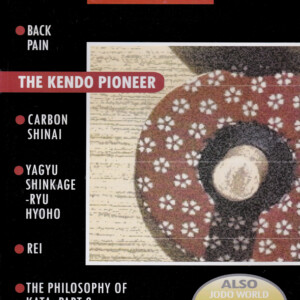

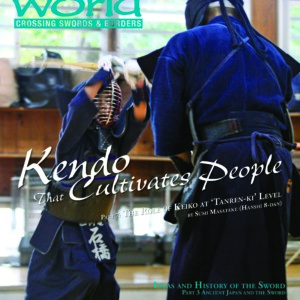
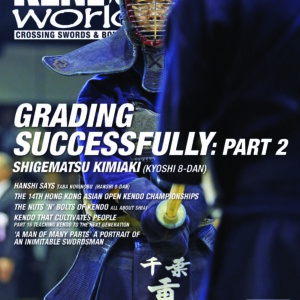

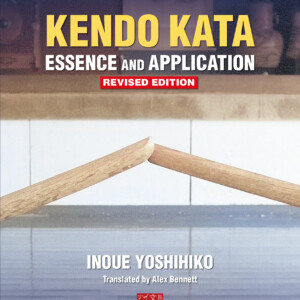
No comments yet.